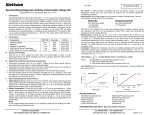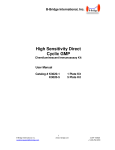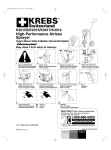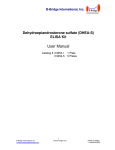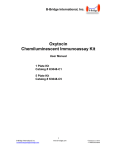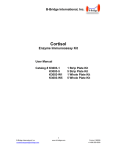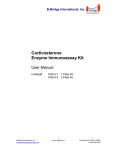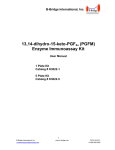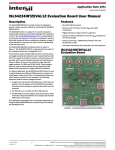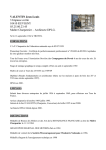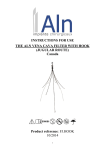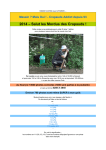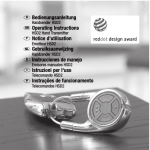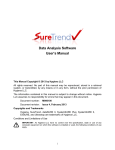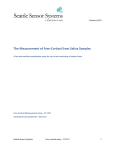Download Cortisone Chemiluminescent Immunoassay Kit - B
Transcript
B-Bridge International, Inc. Cortisone Chemiluminescent Immunoassay Kit User Manual Catalog # K3017-1 1 Plate Kit K3017-5 5 Plate Kit 1 B-Bridge International, Inc. [email protected] www.b-bridge.com Cortisone 150623 +1-408-252-6200 TABLE OF CONTENTS Intended Use 3 Background 3 Assay Principle 3 Kit Components 4 Materials Required 4 Precautions 5 Reagent Preparation 5 Sample Preparation 6 Assay Protocol 6 Calculations 7 Typical Standard Curve Example 7 Notice to Purchaser This product is to be used for Research Purposes Only. It is not to be used for Drug or Diagnostic Purposes, nor is it intended for Human Use. B-Bridge products may not be resold, modified for resale, or used to manufacture commercial products without the express written consent of B-Bridge International, Inc. EXCEPT AS OTHERWISE EXPRESSLY SET FORTH IN THIS USER MANUAL, B-BRIDGE DOES NOT MAKE ANY REPRESENTATION OR WARRANTIES OR CONDITIONS OF ANY KIND, EITHER EXPRESSED OR IMPLIED, WITH RESPECT TO THE PRODUCTS, OR INFORMATION DISCLOSED HEREUNDER, INCLUDING, BUT NOT LIMITED TO, THE IMPLIED WARRANTIES OF MERCHANTABILITY, FIT FOR A PARTICULAR PURPOSE, OR NONINFRINGEMENT OF THE INTELLECTUAL PROPERTY RIGHTS OF THIRD PARTIES. B-Bridge International, Inc. All Rights Reserved. 2 B-Bridge International, Inc. [email protected] www.b-bridge.com Cortisone 150623 +1-408-252-6200 INTENDED USE The B-Bridge Cortisone Chemiluminescent Immunoassay Kit quantitatively measures Cortisone present in extracted dried fecal samples, urine, saliva, and serum samples. This assay is species independent. Please read the complete kit insert before performing this assay. BACKGROUND Cortisone (C21H28O5, Kendall’s Compound ‘E’) was identified by Mason, Myers and Kendall in 1936 as Compound E extracted from bovine suprarenal gland tissue that had the qualitative but not quantitative activity of cortin. The presence of multiple cortin-like compounds led the authors to speculate that the study of Compound E would reveal the nature of cortin. Compound E is now called cortisone and the more active Compound F, cortisol, and the concentrations of these two glucocorticoids vary due to the activity of two 11ß-hydroxysteroid dehydrogenases (11-HSD). While most tissues have the ability to express either enzyme, 11ß-HSD1 is found primarily in the liver where it converts cortisone to cortisol while 11ß-HSD2 is found in tissues such as the kidney where cortisol receptor binding is required. 11ß-HSD2 deactivates cortisol to cortisone, prohibiting receptor activation. This glucocorticoid “shuttle” helps to initiate and regulate the anti-inflammatory response, making cortisone one of the modern “wonder drugs”. Monitoring the ratio of cortisone:cortisol has applications in diabetes, obesity, metabolic syndrome, osteoporosis, and chronic fatigue syndrome in addition to adrenal diseases. Cortisone and cortisol concentrations exhibit a predictable diurnal pattern and can be measured in extracted dried feces, or in serum, plasma, saliva and urine. A recent publication8 has suggested that salivary cortisone is a good surrogate marker for serum cortisol. ASSAY PRINCIPLE The B-Bridge Cortisone Chemiluminescent Immunoassay kit is designed to quantitatively measure Cortisone present in extracted dried fecal samples, urine, saliva, and serum samples. Please read the complete kit insert before performing this assay. 1. 2. 3. 4. 5. Sample or standard added to well in microtiter plate. Cortisone -peroxidase conjugate is added to the standards and samples in the wells. A polyclonal antibody to cortisone is added to each well. Incubate for 2 hours, wash plate, and add substrate to each well. Read luminescence and calculate cortisone concentration from standard curve after short incubation. 3 B-Bridge International, Inc. [email protected] www.b-bridge.com Cortisone 150623 +1-408-252-6200 KIT COMPONENTS Component: Cat # K3017-1 K3017-5 Coated White 96 Well Plates 1 plate 5 plates Cortisone Standard (1,000 ng/mL) 50 μl 125 μl Cortisone Antibody – Rabbit Polyclonal 3 ml 13 ml Cortisone Conjugate Concentrate 1 ml 3.5 ml Conjugate Diluent 3 ml 13 ml Assay Buffer 28 ml 55 ml Dissociation Reagent (use only with serum samples) 1 ml 5 ml 20X Wash Buffer Concentrate 30 ml 125 ml Substrate Solution A 6 ml 28 ml Substrate Solution B 6 ml 28 ml Plate Sealer 1 each 5 each Once opened the kit can be stored at 4°C up to the expiration date on the kit label, except for the PGE2 Conjugate which must be stored at -20°C. MATERIALS REQUIRED BUT NOT SUPPLIED - Distilled or deionized water - Repeater pipet with disposable tips capable of dispensing 25 uL and 100 uL. - A microplate shaker. - 96 well microplate reader capable of reading glow chemiluminescence. All luminometers read Relative Light Units (RLU). These RLU readings will vary with make or model of plate reader. The number of RLUs obtained is dependant on the sensitivity and gain of the reader used. If you are unsure of how to properly configure your reader contact your plate reader manufacturer or carry out the following protocol: Dilute 5 μL of the Cortisone Conjugate Concentrate into 995 μL of deionized water. Pipet 5 μL of diluted conjugate into a white well and add 100 μL of prepared substrate solution (see page 5 for details). This well will give you an intensity close to the maximum binding signal for the assay. Adjust the gain, integration time or sensitivity so that your reader is giving close to its maximum signal. To properly analyze the data software will be required for converting raw RLU readings from the plate reader and carrying out four parameter logistic curve (4PLC) fitting. Contact your plate reader manufacturer for details. 4 B-Bridge International, Inc. [email protected] www.b-bridge.com Cortisone 150623 +1-408-252-6200 PRECAUTIONS As with all such products, this kit should only be used by qualified personnel who have had laboratory safety instruction. The complete insert should be read and understood before attempting to use the product. This kit utilizes a peroxidase-based readout system. Buffers, including other manufacturers Wash Buffers, containing sodium azide will inhibit color production from the enzyme. Make sure all buffers used for samples are azide free. Ensure that any plate washing system is rinsed well with deionized water prior to using the supplied Wash Buffer. In all cases, please consult your institution’s safety procedures for working with hazardous chemicals. REAGENT PREPARATION Allow the kit reagents to thaw and come to room temperature for 30-60 minutes. We recommend that all standards and samples be run in duplicate to allow the end user to accurately determine prostaglandin E2 concentrations. Ensure that all samples have reached room temperature and have been diluted as appropriate prior to running them in the kit. Wash Buffer Dilute Wash Buffer Concentrate 1:20 by adding one part of the concentrate to nineteen parts of de-ionized water. Once diluted this is stable at room temperature for 3 months. Cortisone Conjugate The supplied Cortisone Conjugate Concentrate should be diluted 1:4 with the Conjugate Diluent. Once diluted the Cortisone conjugate is stable for one month when stored at 4°C. Chemiluminescent Substrate Mix one part of the Substrate Solution A with one part of Substrate Solution B in a brown bottle. Once mixed the substrate is stable for one month when stored at 4°C. Standard Preparation 1. Label six test tubes as #1 through #9. 2. Pipet 490 μL of Assay Buffer into tube #1 and 250 μL of Assay Buffer into tubes #2 - #9. 3. Carefully add 10 μL of the cortisone stock solution to tube # 1 and vortex completely. 4. Take 250 μL of the solution in tube #1 and add it to tube #2 and vortex completely. 5. Repeat the serial dilutions for tubes #3 through #9. The concentration of cortisone in tubes 1 through 5 will be 20,000, 10,000, 5,000, 2,500, 1,250, 625, 312.5, 156.3, and 78.1 pg/mL. Use all Standards within 2 hours of preparation. Reagent Assay Buffer Cortisone Stock Standard 1 Standard 2 Standard 3 Standard 4 Standard 5 Standard 6 Standard 7 Standard 8 Standard 9 Final Concentration (pg/mL) Std. 1 490 µl 10 µl Std. 2 250 µl Std. 3 250 µl Std. 4 250 µl Std. 5 250 µl Std. 6 250 µl Std. 7 250 µl Std. 8 250 µl Std. 9 250 µl 250 µl 250 µl 250 µl 250 µl 250 µl 250 µl 250 µl 250 µl 20,000 10,000 5,000 2,500 1,250 625 312.5 156.25 78.1 5 B-Bridge International, Inc. [email protected] www.b-bridge.com Cortisone 150623 +1-408-252-6200 SAMPLE PREPARATION Serum samples need to be treated with the supplied Dissociation Reagent. Addition of this reagent will yield the total cortisone concentration in serum. Dissociation Reagent is to be used only with Serum samples. Free cortisone can be measured in saliva and urine samples as directed below. Dried Fecal Samples Weigh out ≥ 0.2 gm of dried fecal solid into a tube. Add 1 mL of Ethanol (or Ethyl Acetate) for every 0.1 gm of solid and shake vigorously for at least 30 minutes. Centrifuge samples at 5,000 rpm for 15 minutes, then transfer supernatant to a clean tube. Evaporate supernatant to dryness in a SpeedVac or under nitrogen. Store dried extracted samples at -20°C in a desiccator. Just before assaying, dissolve extracted sample with 100μL ethanol and add at least 400μL Assay Buffer. Vortex well, then allow to rest 5 minutes. Do this 2-3 times to ensure complete resuspension. The ethanol concentration in the final Assay Buffer dilution added to the well should be <5%. Run reconstituted diluted samples in assay immediately according to insert directions. Saliva Samples Saliva samples should be frozen and thawed, then centrifuged at 14,000 rpm for 15 minutes. The supernatant should be diluted 1:5 to 1:10 with the supplied Assay Buffer prior running in the assay. Urine Samples Urine samples should be diluted ≥ 1:100 with the supplied Assay Buffer prior running in the assay. Serum Samples Serum samples should be diluted with an equal volume of the supplied Dissociation Reagent. The diluted samples should then be further diluted ≥ 1:50 with the supplied Assay Buffer prior running in the assay. NOTE: Dissociation Reagent is to be used only with Serum samples. Tissue Culture Media For measuring cortisone in tissue culture media (TCM), samples should be read off a standard curve generated in TCM. Samples may need to be diluted further in TCM. Use all samples within 2 hours of preparation. ASSAY PROTOCOL 1. Determine the number of wells to be used and return unused wells to the foil pouch with desiccant. Seal the ziploc plate bag and store at 4˚C. 2. Pipet 50 μL of samples or standards into wells in the plate. 3. Pipet 75 μL of Assay Buffer into the non-specific binding (NSB) wells. 4. Pipet 50 μL of Assay Buffer into wells to act as maximum binding wells (Bo or 0 pg/mL). 5. Add 25 μL of the Cortisone Conjugate to each well using a repeater pipet. 6. Add 25 μL of the Cortisone Antibody to each well, except the NSB wells, using a repeater pipet. 7. Gently tap the sides of the plate to ensure adequate mixing of the reagents. Cover the plate with the plate sealer and shake at room temperature for 2 hours. If the plate is not shaken signals will be approximately 45% lower. 8. Aspirate the plate and wash each well 4 times with 300 μL wash buffer. Tap the plate dry on clean absorbent towels. 9. Add 100 μL of the mixed Chemiluminescent Substrate to each well, using a repeater pipet. 10. Immediately read the luminescence generated from each well in a mutimode or chemiluminescent plate reader using a 0.1 second read time per well. The chemiluminescent signal will decrease about 40% over 60 minutes. 6 B-Bridge International, Inc. [email protected] www.b-bridge.com Cortisone 150623 +1-408-252-6200 11. Use the plate reader’s built-in 4PLC software capabilities to calculate Cortisone concentration for each sample. CALCULATIONS All luminometers read Relative Light Units (RLU). These RLU readings will vary with make or model of plate reader. Average the duplicate RLU readings for each standard and sample. Create a standard curve by reducing the data using the 4PLC fitting routine on the plate reader, after subtracting the mean RLU’s for the NSB. The sample concentrations obtained, calculated from the %B/B0 curve, should be multiplied by the dilution factor to obtain neat sample values. TYPICAL STANDARD CURVE: EXAMPLE ONLY 7 B-Bridge International, Inc. [email protected] www.b-bridge.com Cortisone 150623 +1-408-252-6200









